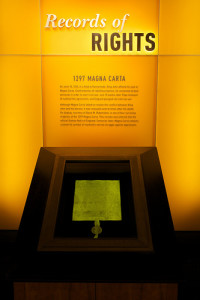 Many of Washington, DC’s museums proudly display the highlights of American history from Judy Garland’s red slippers to the command module of the Apollo 11 mission to the moon. But a new permanent exhibit at the National Archives not only gives us an in-depth look at our country’s complicated past with civil rights, but also asks us to consider how we can play a part in shaping our nation’s future.
Many of Washington, DC’s museums proudly display the highlights of American history from Judy Garland’s red slippers to the command module of the Apollo 11 mission to the moon. But a new permanent exhibit at the National Archives not only gives us an in-depth look at our country’s complicated past with civil rights, but also asks us to consider how we can play a part in shaping our nation’s future.
When you first walk into the dimly lit Records of Rights exhibit at the National Archives, your eyes are drawn directly to the centerpiece of the room, the Magna Carta. When visiting for the first time, I was struck by how the weight of such an important document fills the room. From the screens next to the Magna Carta that allow you to explore its history, to a large interactive table where archive goers are encouraged to sift through historical documents and tag them with their reactions, it is clear that this exhibit aims to draw you in. But it is the images on the walls when you first enter that give the impression that perhaps this exhibit will be more than just a parade of historical documents; the entry is lined with what appear to be frames from a painting of the signing of the Declaration of Independence. However, when the viewer changes their perspective the images change with them: they are holograms. Revealed images start to depict things such as African American soldiers, women’s suffragettes, and immigrant laborers.
These are the real focus of the new Records of Rights exhibit, the recently constructed Rubenstein Gallery that aims to “illustrate how Americans throughout our history have debated issues such as citizenship, free speech, voting rights, and equal opportunity.” The exhibit highlights the struggles of three specific sectors of society: immigrant populations, African Americans and women. On my visit, I focused my energies on the section depicting women, called, “Remembering the Ladies,” a title pulled from a quote from First Lady Abigail Adams as she urged her husband, President John Adams, to “remember the ladies” as they drew up a new code of laws for the new United States of America. The exhibit showed the absurdities of laws and practices that were once commonplace and reminded me that the power of one person and one word (a penciled mark-up adding the word “sex” to the Civil Rights Bill of 1964) can alter the course of history.
Considering how moved I was by the exhibit, I was surprised that there could be any opposition to its depiction of civil rights throughout America’s history. Yet, when the gallery first opened, the New York Times ran a rather critical article that suggested that an exhibit discussing America’s tumultuous past with extending liberties justly should not be so prominently featured at the National Archives. Expressing his criticism, the author, Edward Rothstein, stated, “This is a peculiar way for an institution that is a reflection of the government itself, to see the nature of its origins, the character of its achievements, and the promise of its ideas,” and asked, “What is a visiting class of students to think, except that the United States has been uniquely hypocritical and surpassingly unjust?”
However, after seeing it for myself, I believe the Records of Rights exhibit is exactly the kind of frank and unsparing journey that our students need to understand and appreciate how their own rights and liberties have been shaped to this day. This look at our country’s history – and its fraught relationship with implementing the “rights of free men” that Mr. Rothstein extols – shows that the “promise of [this country’s] ideas” has historically only been guaranteed for some – often those writing the ideas – and reminds students that if we forget this truth, we run the risk of repeating it. Facing these tough issues in America’s history is exactly what we want a visiting class of students to do; a trip to the Archives is not meant to be a glamorous whitewashing of our nation’s story, but rather a teaching experience that sparks debate. If we don’t show these struggles in our National Archives, what students will learn is revisionist history, that the “hard parts” of delivering these rights to our citizens can be brushed under the rug. Taking responsibility for our history is not a sign of weakness, but rather a way to ensure the strength of our nation in the future. 
In this day and age we take it for granted that a woman can grow up to become a doctor or business owner, that she can build her own credit and buy her own home (a right the exhibit reminds wasn’t granted until the 1970’s), and that women don’t need to be taught how to use job related equipment by “referring to them like kitchen gadgets” as one booklet in the exhibit urged new managers of women to do (à la this gem). It took the concentrated efforts of thousands of people to see where inequality existed and try to overcome those stereotypes. The honesty of the Records of Rights exhibit is less about how America is imperfect, and more about how America has overcome many obstacles in its journey to form a more perfect union: when faced with a problem, individuals as part of a larger American society, helped push us forward.
Rothstein also lamented that in the exhibit, “we aren’t being asked to think: We are being drilled, unrelentingly, in injustice,” and later, “The exhibition notes that Americans have “debated issues” like these, but there is no debate — only compassion opposing intolerance.” Yet, I believe the Records of Rights exhibit does an exceptional job of showing us how Americans have debated these issues; only because of our privilege of hindsight can we look back and see that the rights we fought for were really just “compassion opposing intolerance.” For instance, a letter from Alice H. Wadsworth, the female President of the National Association Opposed to Woman Suffrage, to U.S. House of Representatives member Charles E. Fuller, states that giving women the right to vote would be “an endorsement of nagging as a national policy.” Other documents in the exhibit also depict how the Equal Rights Amendment (ERA) was opposed by key woman suffragists for fear it would wipe away gains made through gender specific labor legislation. Eleanor Roosevelt opposed the ERA. The Record of Rights’ nuanced and comprehensive portrayal of our history reminds us that there were multiple sides to these issues, and these debates were very real for our citizens, even among women. In many ways, it is exactly the job of The Archives, as our nation’s keeper of historical records, to show us the totality of this debate.
 Moreover, this exhibit reveals that some of the struggles of bygone eras are struggles we still face today. For instance, I couldn’t help but note that political cartoons from the 1940s joked about the lack of childcare for women in the workforce during the wartime effort, a very real issue that we are still working to address today. In many cases, we still haven’t learned from our past.
Moreover, this exhibit reveals that some of the struggles of bygone eras are struggles we still face today. For instance, I couldn’t help but note that political cartoons from the 1940s joked about the lack of childcare for women in the workforce during the wartime effort, a very real issue that we are still working to address today. In many cases, we still haven’t learned from our past.
When leaving the exhibit, I felt equal parts exhilarated and sobered. We as a nation have come together to recognize and right injustice time and time again, something that propels us forward and makes us stronger. But there are many things we still need to improve, and reminding ourselves of this is the only way we will know that we have the ability to change things. The exhibit highlighted individuals – whether it be a woman writing the state railway commission asking for a chance to work for a living wage, or famous suffragists calling for the 19th Amendment to be passed; these remind us that no matter who or where we are, we can play a role in changing history.


